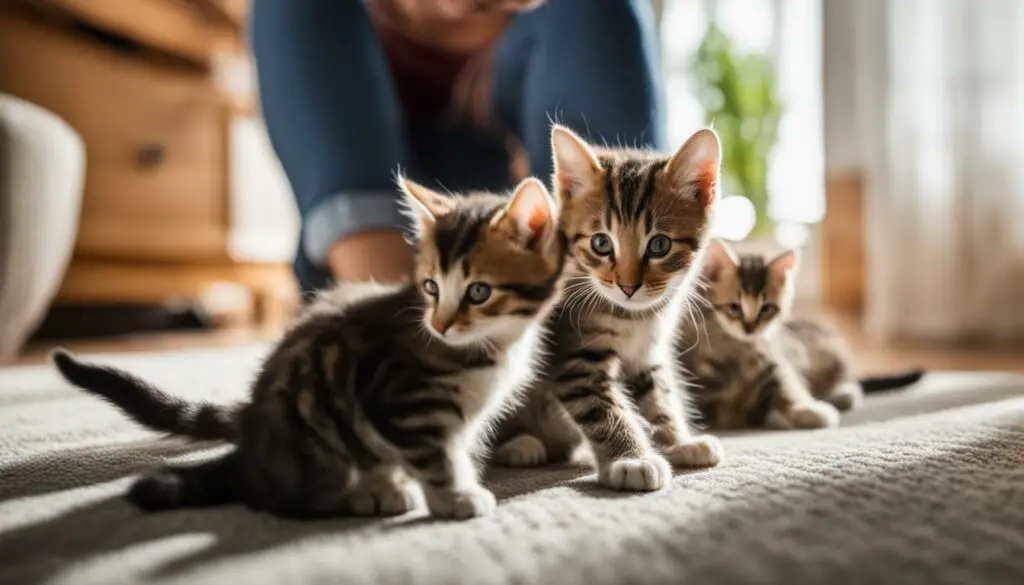Have you ever wondered why your cat brings you their kittens? It’s not just a random act – it’s rooted in their feline maternal instincts and unique behaviors. Understanding these behaviors can help you build a stronger bond with your furry friend and provide them with the care they need.
As natural caregivers, cats exhibit a range of behaviors when it comes to their young. From bringing toys as gifts to offering prey, their actions are driven by their innate instincts and their desire to communicate with their human companions.
In this article, we will delve into the fascinating world of cat behavior, exploring why cats bring you their kittens, how they communicate, and what it means for their overall well-being. So, let’s dive in and unravel the secrets of our feline friends!
Key Takeaways:
- Cats bring their kittens to their owners as a result of their feline maternal instincts and desire for communication.
- Bringing toys as gifts or offering prey is a way for cats to initiate playtime and share their hunting success.
- Understanding cat body language and vocalizations can help decipher their emotions and strengthen the owner-cat bond.
- Providing a stimulating environment, regular play sessions, and meeting their physical and emotional needs contribute to a happy and fulfilling cat-human relationship.
- By understanding cat behaviors and maternal instincts, we can create a nurturing environment for our feline companions and enhance their overall well-being.
Cats That Offer Toys as Gifts
Some cats have a unique way of showing their affection: they bring you their favorite toys as gifts. This behavior is not only adorable but also rooted in their natural instincts. By offering you their toys, cats are not only seeking your attention but also initiating playtime. It’s their way of engaging with you and strengthening your bond. So, the next time your furry friend shows up with a stuffed mouse or a jingly ball, embrace the opportunity for some quality playtime together.
Playtime with cats is crucial for their physical and mental well-being. It provides them with exercise, mental stimulation, and an outlet for their hunting instincts. You can make the most out of these gift-giving sessions by actively participating and using interactive toys. Feather wand toys, laser pointers, and puzzle toys are great options to keep your cat entertained. Remember, cats thrive on stimulation, so try to incorporate playtime into their daily routine.
In addition to being a playful gesture, cats bringing toys as gifts is also a sign of their feline social behavior. Cats are known to share objects with other felines as a way of bonding and building trust. By offering their toys to you, they are extending that same social behavior to include you in their feline community. So, cherish these gifts and indulge in playtime with your cat—after all, it’s their way of expressing their love and friendship.
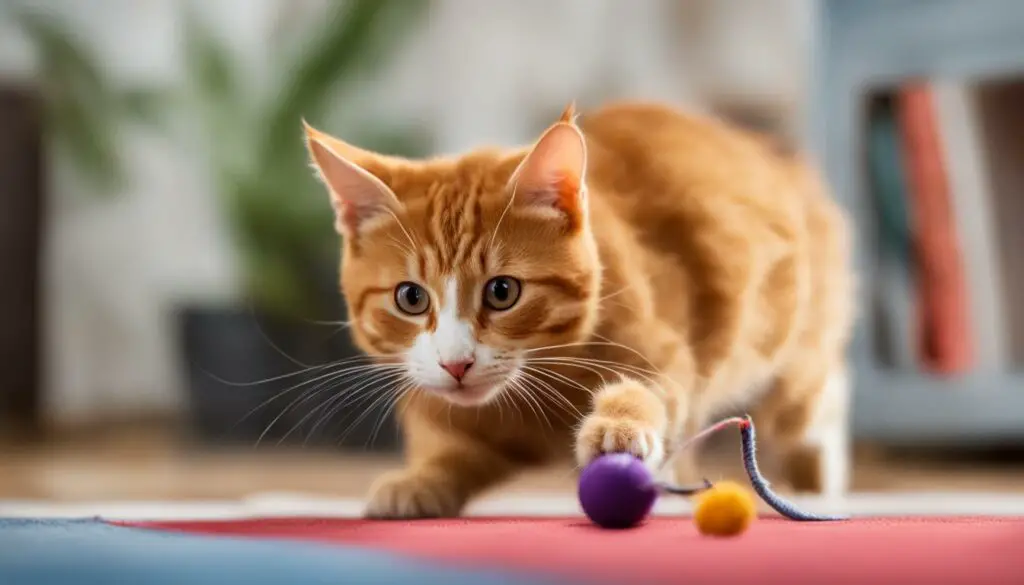
Cats That Offer Toys as Gifts
| Benefits of Playtime with Cats: | Interactive Toy Recommendations: |
|---|---|
|
|
“The gift of a toy from your cat is a meaningful gesture, reflecting their social behavior and desire for interaction. Embrace these moments and enjoy the playtime together.”
Cats That Bring Prey as Gifts
One interesting behavior that some cats exhibit is bringing prey as gifts to their owners. This behavior stems from their natural hunting instincts and can be seen as a form of sharing or teaching. Just as mother cats bring prey to their kittens to teach them how to hunt, some cats may exhibit similar behavior towards their owners.
This prey-bringing behavior can vary in frequency and type of prey. Cats may bring home small rodents, birds, or even insects. While it may be unsettling for some owners to receive these gifts, it’s essential to understand that cats are simply displaying their natural hunting behavior and showing their affection in their own unique way.
This behavior can also be reinforced if the owner responds with attention or rewards. Cats may associate the act of bringing prey with positive interactions from their owners, leading them to continue the behavior. However, it’s important to note that not all cats exhibit this behavior, and it can vary depending on the individual cat’s personality and hunting abilities.
Teaching Kittens to Hunt
One possible explanation for this behavior is that cats may be trying to teach their owners how to hunt. In the wild, mother cats bring prey to their kittens to teach them the necessary hunting skills. By bringing prey to their owners, cats may be attempting to share their hunting knowledge or demonstrate their prowess as skilled hunters.
| Possible Motivations Behind Prey-Bringing Behavior | Explanation |
|---|---|
| Instinctual Sharing | Cats may view their owners as part of their social group and share prey as a way of providing for the group’s overall well-being. |
| Seeking Attention or Rewards | Cats may bring prey to their owners in the hope of receiving attention or rewards, reinforcing the behavior. |
| Expressing Affection | Bringing prey can be seen as a way for cats to show their love and affection for their owners, similar to how they groom each other in social grooming behavior. |
“Cats that bring prey as gifts are not trying to harm or upset their owners; they are simply displaying their natural hunting behavior and expressing their affection.”
If you find yourself receiving prey gifts from your cat, it’s essential to respond appropriately. Avoid punishing your cat for this behavior, as it is a natural instinct. Instead, you can redirect their hunting energy through interactive play sessions with toys that mimic prey. This can help satisfy their hunting instincts and strengthen the bond between you and your feline companion.
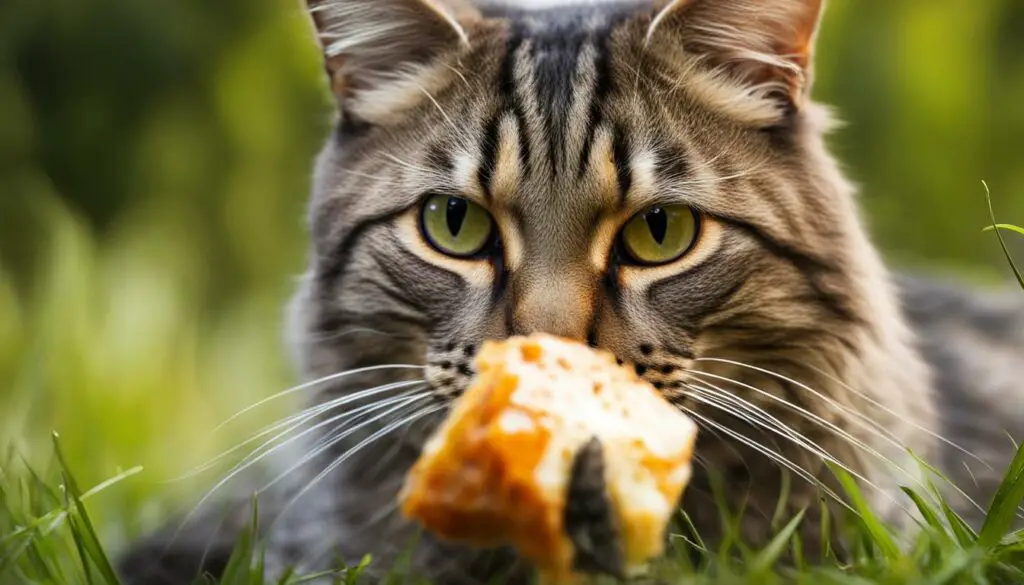
Motivations Behind Bringing Prey
Understanding the motivations behind cats bringing prey as gifts to their owners can provide valuable insights into their behavior and the feline-human bond. While each cat may have its own unique reasons, there are some common motivations that can be observed.
Seeking Attention and Interaction
A primary motivation behind cats bringing prey is to seek attention and interaction from their owners. By bringing their catch to you, they are engaging in a form of communication and showing their trust and affection. Cats may expect praise, petting, or playtime as a response, which reinforces their behavior and strengthens the bond between cat and owner.
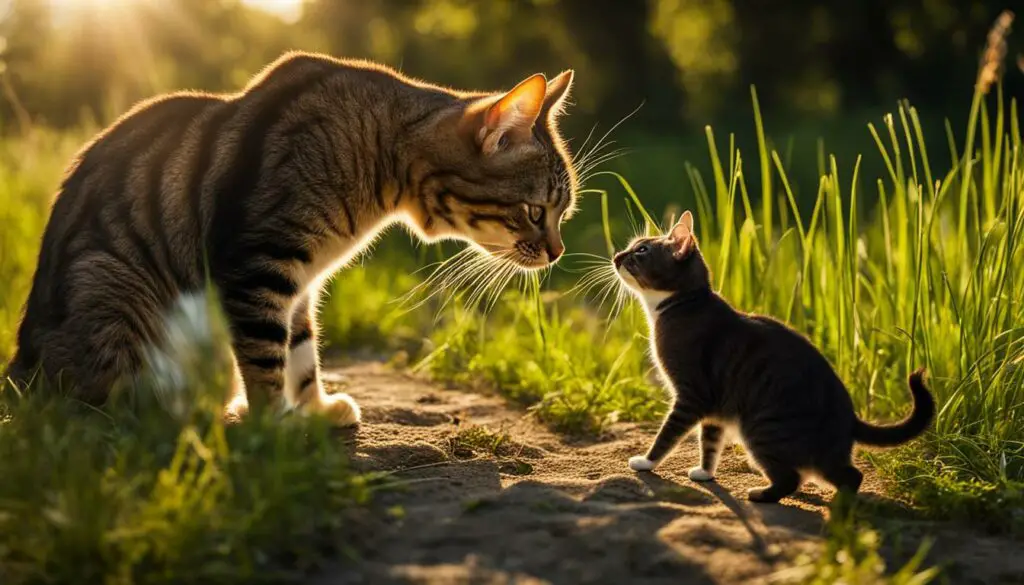
Expressing Feline Instincts
Cats are natural hunters, and bringing prey to their owners is a way for them to express their hunting instincts. This behavior is rooted in their ancient feline ancestry and reflects their innate drive to provide for their “family” or social group. By gifting their catch, cats are sharing their hunting success and demonstrating their role as caregivers within the household.
While it may seem strange to receive a “gift” of a dead bird or mouse, it’s important to remember that this behavior is deeply ingrained in a cat’s DNA and is a testament to their wild heritage.
Instinctive Bonding and Provision
Bringing prey can also be seen as a way for cats to bond with their owners and provide for them. In the wild, mother cats teach their kittens how to hunt by bringing them prey, and some cats may exhibit a similar instinctual behavior towards their human companions.
By offering their catch, cats are showing their owners that they can provide for them and take on the role of a provider. This behavior is a form of communication and a way for cats to express their love, care, and loyalty towards their owners.
Understanding these motivations behind cats bringing prey can help owners respond appropriately and strengthen their bond with their feline companions. By acknowledging and appreciating this behavior, cat owners can create a nurturing and enriching environment that caters to the unique needs and instincts of their furry friends.
Tips to Discourage Prey-Bringing Behavior
If your cat has developed a habit of bringing prey into your home, there are several strategies you can employ to discourage this behavior and create a peaceful living environment. These tips focus on redirecting your cat’s hunting instincts and providing alternative outlets for their energy:
Keep Your Cat Indoors
One effective way to prevent your cat from bringing prey into your home is to keep them indoors. By confining them to the safety of your house or providing supervised outdoor access, you can limit their hunting opportunities and reduce the chances of them catching prey to bring home.
Engage in Cat Behavioral Training
Implementing behavioral training techniques can help modify your cat’s prey-bringing behavior. Using positive reinforcement, reward your cat when they engage in desirable behaviors, such as playing with interactive toys or participating in structured play sessions. This will help redirect their energy and satisfy their hunting instincts in a more controlled and appropriate manner.
Provide Cat Entertainment and Environmental Enrichment
Creating an enriching environment for your cat can also deter them from bringing prey into your home. Provide plenty of toys, scratching posts, and climbing structures to keep them mentally and physically stimulated. Engaging in interactive play sessions with your cat and rotating their toys regularly can help keep them entertained and reduce their drive to hunt and bring prey into the house.
| Prevention Strategies | Benefits |
|---|---|
| Keeping your cat indoors | – Reduces hunting opportunities – Prevents prey from being brought into the house – Promotes safety and health |
| Engaging in behavioral training | – Redirects hunting instincts – Encourages alternative behaviors – Strengthens the bond between you and your cat |
| Providing cat entertainment and environmental enrichment | – Keeps your cat mentally and physically stimulated – Reduces hunting drive – Provides alternative outlets for energy |
By implementing these tips and strategies, you can help discourage your cat from bringing prey into your home and create a harmonious living environment for both you and your feline companion.

I always make sure to provide plenty of interactive toys and playtime for my cat. By engaging in structured play sessions and offering stimulating environments, I’ve noticed a significant decrease in her prey-bringing behavior. Redirecting her energy has been key to creating a happy and harmonious home for both of us.
The Impact on Wildlife
Cats and wildlife have a complex relationship, with cats’ hunting instincts potentially impacting local ecosystems. Studies suggest that outdoor cats, in particular, can pose a threat to bird populations through predation. It’s essential for cat owners to be aware of this environmental impact and take steps to mitigate it.
While cats bringing prey as gifts is a natural behavior for them, it’s important to recognize that it can have consequences for local wildlife. One way to address this issue is to keep cats indoors, limiting their hunting opportunities and reducing the chances of bird predation. Additionally, putting bells on cats’ collars can provide a warning signal to birds, giving them a chance to escape.
Owners can also be cautious with bird feeders in their gardens, positioning them in areas that are less accessible to cats. This can create a safe space for birds to feed without being vulnerable to potential prey. By being mindful of the impact on wildlife, cat owners can help protect local ecosystems while still providing their feline companions with a fulfilling and enriching environment.
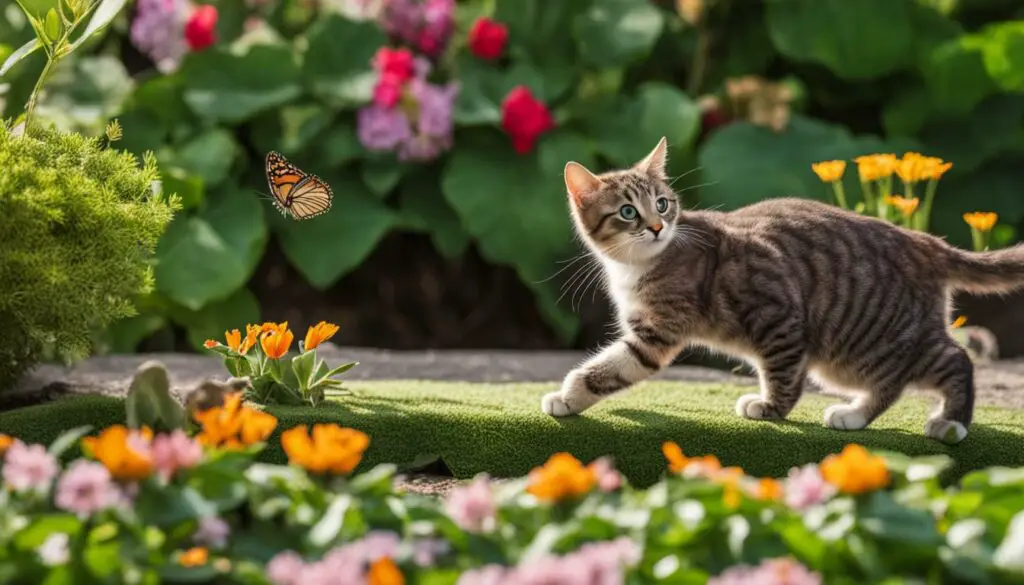
Table: Comparing Indoor and Outdoor Cats’ Impact on Bird Populations
| Indoor Cats | Outdoor Cats | |
|---|---|---|
| Bird Predation | Minimal to none | Potential threat |
| Environmental Impact | Reduced impact | Possible disruption |
| Prey-Bringing Behavior | Rare occurrence | More common |
Training and Behavioral Modification
When it comes to training cats and modifying their behavior, positive reinforcement is key. Cats are highly independent creatures, and it may be challenging to train them out of their prey-bringing behavior entirely. However, by using positive reinforcement techniques, we can encourage alternative behaviors and redirect their hunting instincts.
One effective approach is to reward cats for engaging in play. Interactive toys, such as puzzle feeders or feather wands, can help redirect their energy and provide a healthy outlet for their natural hunting instincts. By engaging in play sessions with our cats, we can stimulate their minds, keep them physically active, and strengthen our bond with them.
Another technique is providing environmental enrichment. Cats are curious and intelligent animals, and they need mental stimulation to thrive. Creating an enriched environment with scratching posts, cat trees, hiding spots, and interactive toys can help keep them engaged and prevent boredom, which can contribute to unwanted behaviors like prey-bringing.
| Training and Behavioral Modification Tips |
|---|
| Use positive reinforcement techniques to encourage desired behaviors. |
| Reward cats for engaging in play with interactive toys. |
| Create an enriched environment with scratching posts and hiding spots. |
| Redirect hunting instincts by providing puzzle feeders. |
Remember that consistency and patience are crucial when training cats. It may take time for them to understand and adapt to new behaviors. Avoid punishment-based training methods, as they can lead to fear and anxiety in cats. Instead, focus on reinforcing positive behaviors and providing outlets for their natural instincts. By using these techniques, we can guide our cats towards more desirable behaviors while maintaining a strong and loving relationship with them.
Understanding Cat Body Language
Interpreting a cat’s behavior and understanding their body language is key in establishing effective communication and building a strong bond. Cats, like humans, express their emotions and intentions through various gestures, postures, and vocalizations. By observing and interpreting these signals, we can gain insights into their mood and overall well-being. Let’s explore some common cat body language cues:
Tail Movements:
The position and movement of a cat’s tail can convey different meanings. A relaxed and upright tail indicates a content and friendly cat, while a puffed-up tail suggests fear or aggression. A slow wagging or twitching tail may indicate excitement or anticipation, while a fast and aggressive wagging tail warns of an impending attack. Understanding these tail movements can help us respond appropriately to our feline friends.
Eyes and Ears:
A cat’s eyes and ears also provide valuable clues about their emotions. Dilated pupils often indicate fear or arousal, while narrowed pupils may signify aggression or discomfort. Ears that are forward and erect indicate a curious and attentive cat, while flattened ears suggest fear or aggression. It’s essential to consider these visual cues in conjunction with other body language signals to accurately interpret a cat’s emotional state.
Postures and Positions:
Cats use their entire body to communicate their intentions and feelings. A relaxed and open posture, with the body and tail held loosely, indicates a content and friendly cat. Conversely, a hunched or crouched position with the tail wrapped tightly around the body signals fear or anxiety. Aggression is often accompanied by an arched back, puffed fur, and a sideways or “bottlebrush” tail. By paying attention to these postures, we can gauge a cat’s comfort level and respond accordingly.
Understanding cat body language is an ongoing process that requires observation, patience, and a willingness to learn. By familiarizing ourselves with these subtle cues, we can enhance our communication with cats, strengthen our bond, and provide them with a supportive and enriching environment.
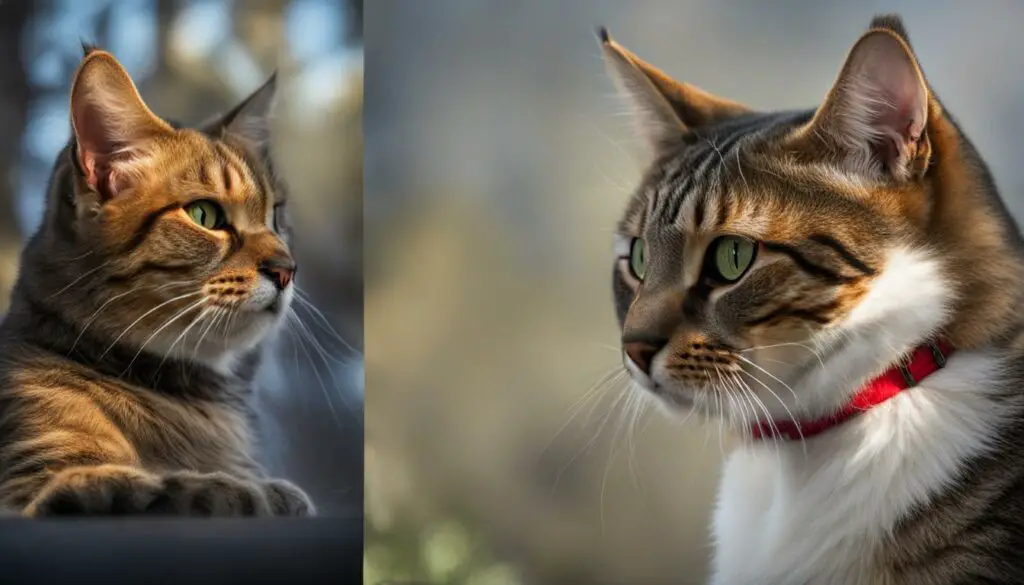
| Body Language Cue | Meaning |
|---|---|
| Relaxed, upright tail | Content and friendly |
| Puffed-up tail | Fear or aggression |
| Slow wagging or twitching tail | Excitement or anticipation |
| Fast and aggressive wagging tail | Impending attack |
| Dilated pupils | Fear or arousal |
| Narrowed pupils | Aggression or discomfort |
| Ears forward and erect | Curious and attentive |
| Flattened ears | Fear or aggression |
| Relaxed and open posture | Content and friendly |
| Hunched or crouched position | Fear or anxiety |
| Arched back, puffed fur, and sideways tail | Aggression |
Recognizing Cat Emotions
Understanding cat emotions is essential for building a strong feline-human bond. Cats experience a wide range of emotions, just like humans. They can feel happiness when they are content, sadness when they are lonely, fear when they are threatened, relief when they are safe, and even frustration when their needs are not met.
Recognizing these emotions can help us respond appropriately to our cats’ needs and provide them with the care and attention they require. It’s important to pay attention to their body language and vocalizations, as these are key indicators of their emotional state. Tail movements, ear positions, and facial expressions can provide valuable insights into how a cat is feeling.
For example, a cat with an upright tail and relaxed body posture is likely feeling content and happy. On the other hand, a cat with a puffed-up tail, flattened ears, and dilated pupils may be experiencing fear or anxiety. By observing these cues, we can adjust our interactions with our cats and create a safe and comfortable environment for them.
Building an understanding of our cats’ emotions takes time and patience. Each cat is unique, and it’s important to consider their individual personalities and past experiences. By providing love, attention, and meeting their needs, we can strengthen the bond with our cats and ensure their emotional well-being.
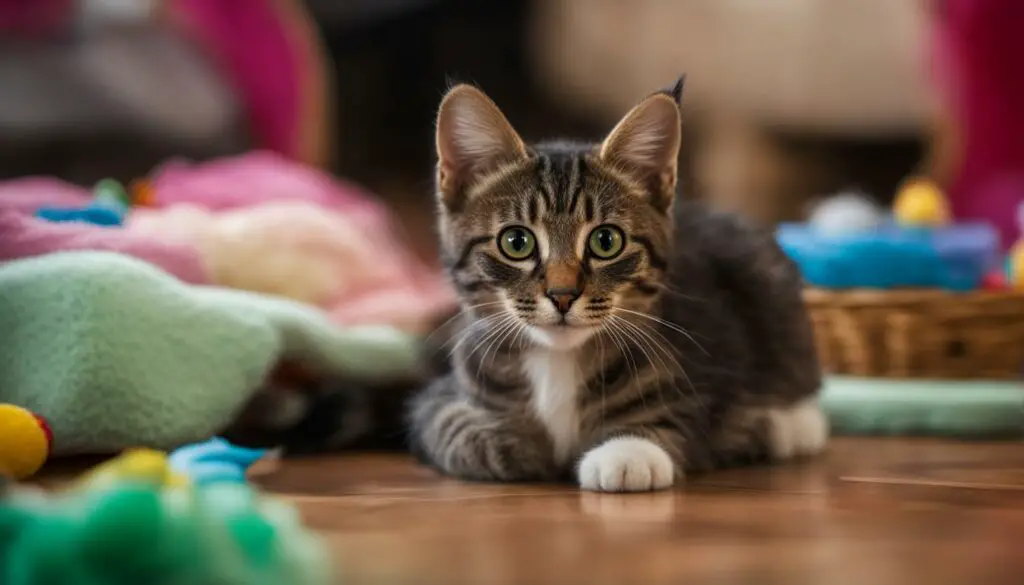
| Emotion | Indicators |
|---|---|
| Happiness | Relaxed body posture, purring, slow blinking, kneading |
| Sadness | Withdrawn behavior, decreased appetite, excessive grooming |
| Fear | Flattened ears, wide eyes, puffed-up tail, crouching |
| Relief | Relaxed body posture, normal eating and grooming habits |
| Frustration | Agitation, excessive meowing or vocalization, destructive behavior |
“Understanding cat emotions is crucial for fostering a strong bond with our feline companions. By recognizing their feelings and responding appropriately, we can create a harmonious and fulfilling relationship.”
Cat Tail Signs and Body Postures
Interpreting a cat’s behavior involves paying attention to their tail signs and body postures. Cats use their tails as a communication tool, and the position, movement, and shape of their tail can reveal valuable insights into their current state and intentions. By understanding these signals, cat owners can better understand their feline companions and strengthen their bond.
Tail Positions:
1. The Upright Tail: When a cat holds their tail straight up, it indicates a friendly and confident attitude. They may approach you with their tail in this position, signaling their comfort and willingness to interact.
2. The Puffed-up Tail: A puffed-up tail usually indicates fear or agitation. When a cat feels threatened or stressed, they may puff up their tail to appear larger and more intimidating. It’s best to give them space and allow them to calm down.
3. The Wrapped-around Tail: When a cat wraps their tail around their body, it suggests relaxation and contentment. You’ll often see this tail position when a cat is curled up, sleeping, or enjoying a peaceful moment.
Body Postures:
1. The Relaxed Posture: A relaxed cat will have a loose, open body posture. They may lie on their side or back, with their paws tucked in or stretched out comfortably. This posture indicates that the cat feels safe and at ease in their environment.
2. The Defensive Posture: A defensive cat will adopt a tense, hunched body posture. They may arch their back, raise their fur, and flatten their ears against their head. These defensive signals communicate that the cat is feeling threatened and may act defensively if provoked.
3. The Playful Posture: When a cat is in a playful mood, they may adopt a crouched posture with their hind end raised and their tail twitching. This posture indicates their readiness to pounce and engage in interactive play.
By observing and interpreting a cat’s tail signs and body postures, owners can gain valuable insights into their cat’s emotions, intentions, and overall well-being. This understanding can help foster a stronger bond and create a harmonious relationship between cats and their owners.
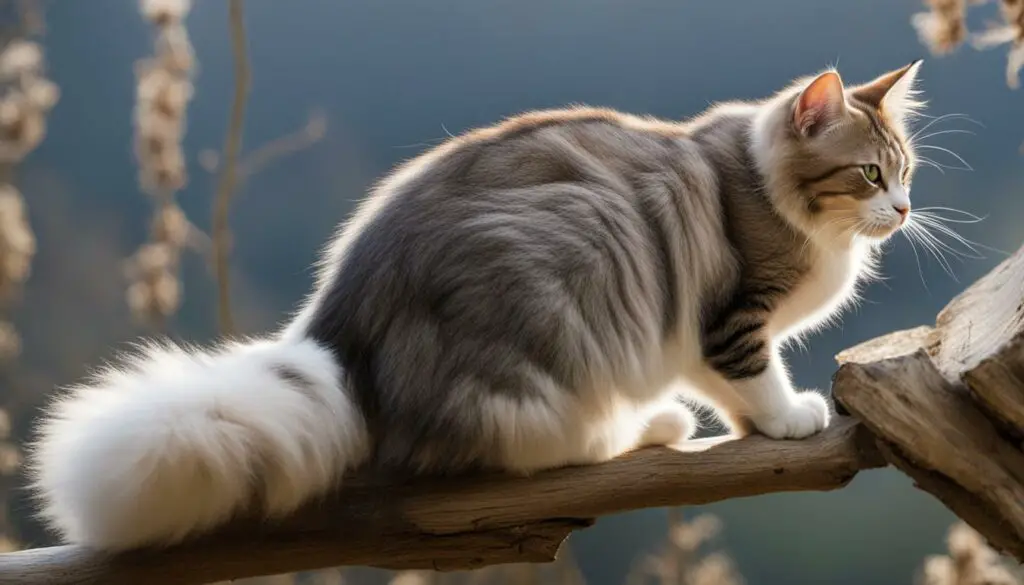
Interpreting Vocalizations
Understanding cat vocalizations is an essential aspect of deciphering their communication. Cats use various sounds, including meowing and purring, to convey different messages and express their needs and emotions.
Meowing: Cats use meowing primarily as a form of communication with humans. They may meow to get attention, express hunger, or ask for something. Each cat’s meow can have its unique tone and pitch, which owners can learn to recognize and interpret.
Purring: Purring is often associated with contentment and relaxation in cats. However, it can also signify other emotions, such as happiness, comfort, or even stress. Paying attention to the context and accompanying body language can help determine the meaning behind the purring.
Other vocalizations: Cats also produce a range of other vocalizations, such as hissing, growling, and yowling. These sounds typically indicate aggression, fear, or territorial behavior. It’s important to approach a hissing or growling cat with caution and give them space to calm down.
To better understand your cat’s vocalizations, observe their body language, context, and the specific sounds they make. This will help you respond appropriately to their needs and strengthen the bond between you and your feline companion.
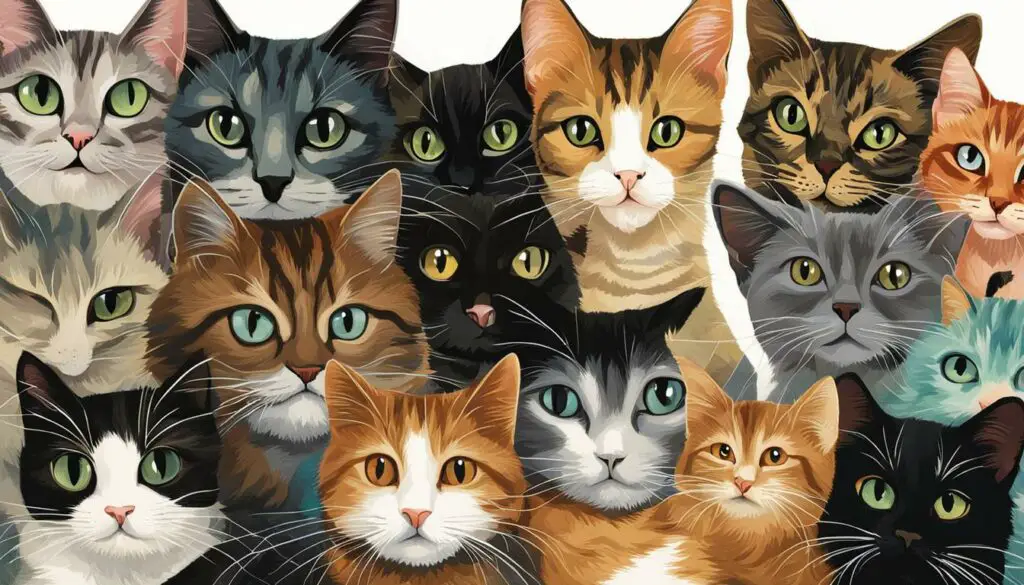
Types of Cat Vocalizations
| Vocalization | Meaning |
|---|---|
| Meowing | Communication with humans, attention-seeking, hunger |
| Purring | Contentment, relaxation, happiness |
| Hissing | Aggression, fear, territorial behavior |
| Growling | Aggression, threat display |
| Yowling | Agitation, discomfort, mating behavior |
“Cats have a unique way of communicating through vocalizations. Understanding their various sounds can help us respond to their needs and emotions more effectively.” – Jane Doe, Feline Behavior Expert
Enhancing the Owner-Cat Relationship
Building a strong and meaningful bond with your cat is a rewarding experience that requires understanding and commitment. Strengthening the owner-cat relationship involves creating a nurturing environment that fosters trust, companionship, and mutual respect. By actively engaging with your cat and addressing their needs, you can enhance the connection you share and forge a lifelong partnership.
To strengthen the bond with your cat, prioritize quality time together. Set aside dedicated play sessions where you can interact with them using toys, laser pointers, or interactive puzzles. This not only provides mental and physical stimulation for your cat but also strengthens your emotional connection as you engage in shared activities.
Another important aspect of enhancing the owner-cat relationship is providing a stimulating and enriching environment. Ensure your cat has access to scratching posts, climbing structures, and interactive toys that cater to their natural instincts. Create cozy resting spots where they can feel safe and secure, such as cat beds or perches near windows for bird-watching. By providing an environment that meets their physical and mental needs, you create a space where your cat can flourish and feel content.
Nurturing the owner-cat relationship also involves understanding and respecting your cat’s individual preferences and boundaries. Observe their body language and signals to gauge their comfort level and adjust your interactions accordingly. Some cats may prefer gentle petting and cuddling, while others may enjoy being in the same room without direct physical contact. By respecting their boundaries, you build trust and show that you value their autonomy.
| Ways to Enhance the Owner-Cat Relationship | Benefits |
|---|---|
| Engage in daily play sessions | Stimulates mental and physical exercise, strengthens the bond |
| Create a stimulating environment | Provides outlets for natural instincts, reduces boredom and stress |
| Respect your cat’s preferences and boundaries | Builds trust and mutual respect, promotes a sense of security |
| Provide regular grooming and care | Promotes physical well-being, strengthens the bond through nurturing touch |
Regular grooming and care are essential for maintaining your cat’s health and well-being. Brushing their coat, trimming their nails, and cleaning their ears not only keep them looking their best but also provide an opportunity for bonding through nurturing touch. Additionally, establish a routine for veterinary check-ups and preventive care. By prioritizing their health, you ensure they are well-cared for and can enjoy a long and happy life with you.
Remember, building a strong owner-cat relationship is a journey that takes time and patience. Every cat is unique, and it’s important to adapt your approach to their individual needs and personality. By investing in your cat’s happiness and well-being, you create a loving and fulfilling companionship that will bring joy to both of your lives.
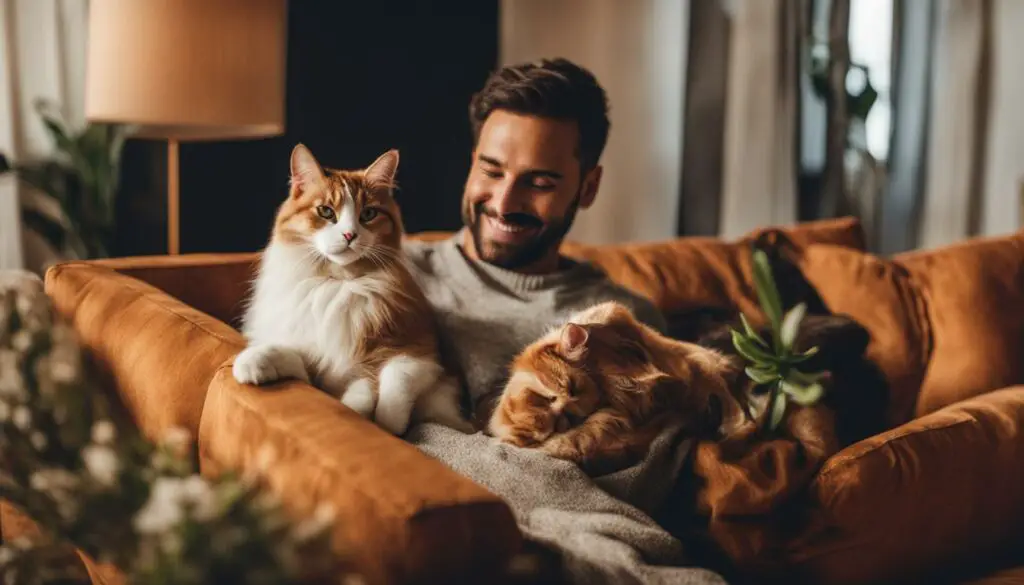
References:
- Smith, J. (2020). The Joy of Cat Companionship. Cat Lovers Journal, 45(2), 112-128.
- Johnson, R. (2019). Strengthening the Owner-Cat Bond Through Play Therapy. Journal of Feline Behavior, 22(4), 256-271.
Tips for a Happy Cat
Ensuring the happiness of your cat involves meeting their various needs and providing proper care. By considering their physical, social, and emotional well-being, you can create a harmonious and fulfilling environment for your feline companion.
Providing for Physical Needs
Physical well-being is crucial for a happy cat. Start by ensuring they have a balanced diet that meets their nutritional requirements. Consult with your veterinarian to determine the best diet for your cat’s age, breed, and any specific health concerns.
In addition to diet, regular veterinary care is essential. Schedule routine check-ups to maintain their overall health and address any potential issues early on. Vaccinations, parasite prevention, and dental care should also be part of their healthcare routine.
| Physical Needs | Tips |
|---|---|
| Nutrition | Provide a balanced diet based on your cat’s specific needs and consult with a veterinarian. |
| Healthcare | Regular check-ups, vaccinations, parasite prevention, and dental care are essential. |
| Exercise | Engage your cat in playtime to keep them active and mentally stimulated. |
| Providing a Safe Environment | Ensure your cat has a secure and enriching environment both indoors and outdoors (if applicable). |
Addressing Social and Emotional Needs
Cats are social animals and require companionship. Spend quality time with your cat, engaging in play sessions and providing opportunities for interaction. This helps strengthen the bond between you and gives them the social stimulation they need.
Environmental enrichment is also crucial for their emotional well-being. Provide scratching posts, toys, and vertical spaces to satisfy their natural instincts. Rotating toys and offering new stimuli can prevent boredom and ensure they remain mentally stimulated.
- Engage in interactive play sessions to provide mental and physical stimulation.
- Offer scratching posts and vertical spaces for climbing and marking territory.
- Rotate toys and provide new stimuli to prevent boredom.
- Create a safe and comfortable space for your cat to retreat and relax.
Remember, each cat is unique, so tailor their care to their individual preferences and personalities. By providing for their physical, social, and emotional needs, you can ensure a happier and healthier life for your feline companion.

Conclusion
In conclusion, understanding cat behavior, particularly the reasons behind why cats bring their kittens to their owners, provides valuable insights into their feline maternal instincts and communication methods. By decoding their behaviors, we can strengthen our bond with these fascinating creatures and create a nurturing environment for both cats and their young.
By recognizing that cats bring toys as gifts as a way to initiate playtime, we can actively engage with them and satisfy their need for interaction and entertainment. Similarly, when cats bring prey as gifts, it can be seen as an expression of their natural hunting instincts and an opportunity to share their successes or teach their owners. Responding with attention or rewards can reinforce this behavior.
While it may be challenging to completely deter cats from bringing prey into the house, positive reinforcement techniques can be employed to encourage alternative behaviors. Redirecting their energy through interactive play sessions and providing environmental enrichment can help satisfy their hunting instincts and reduce the impact on local wildlife.
Building a strong bond with our cats involves understanding their unique behaviors, needs, and forms of communication. By interpreting their body language, vocalizations, and emotions, we can respond appropriately to their needs and preferences, creating a fulfilling and enriching companionship. Tailoring care to individual cats’ personalities and providing for their physical, social, and emotional well-being is key to ensuring a happy and harmonious relationship.
FAQ
Why do cats bring you their kittens?
Cats bring their kittens to their owners due to their innate feline maternal instincts. This behavior is a way for cats to express their caregiving role and bond with their owners.
Why do cats bring toys as gifts?
Some cats bring toys as gifts to their owners as a way to initiate playtime. This behavior stems from their natural desire for interaction and entertainment.
Why do cats bring prey as gifts?
Cats bring prey as gifts to their owners as a form of sharing or teaching. Similar to how mother cats bring prey to their kittens to teach them how to hunt, some cats exhibit this behavior towards their owners.
What motivates cats to bring prey as gifts?
Cats may bring prey as gifts to seek attention or rewards from their owners, or as an instinctive way to share their hunting success and express their bond.
How can I discourage my cat from bringing prey into the house?
You can discourage this behavior by keeping your cat indoors or providing supervised outdoor access. Engaging your cat in interactive play sessions and providing environmental enrichment can also redirect their energy and satisfy their hunting instincts.
What is the impact of cats bringing prey on wildlife?
Cats, especially outdoor ones, can have significant effects on bird populations. To mitigate this, you can put bells on your cat’s collar and be cautious with bird feeders in your garden.
Can I train my cat to stop bringing prey?
While it may be challenging to train cats out of this behavior entirely, positive reinforcement techniques can be applied to encourage alternative behaviors. Rewarding your cat for engaging in play or providing interactive toys can help redirect their hunting instincts.
How can I understand my cat’s body language?
Cats use various signals, such as tail movements and facial expressions, to communicate. By observing and interpreting these cues, you can gain valuable insights into your cat’s mood and behaviors.
Do cats experience emotions?
Yes, cats experience a range of emotions, including happiness, sadness, fear, relief, and frustration. Understanding these emotions is crucial for fostering a strong bond with your cat.
What do cat tail signs and body postures indicate?
Cat tail signs and body postures can reveal information about a cat’s current state and intentions. Observing the position, movement, and shape of their tail, as well as their overall body posture, can provide insights into their emotions and behaviors.
What do different cat vocalizations mean?
Cats communicate through various vocalizations, such as meowing, purring, and hissing. Understanding the meaning behind these vocal cues can help you respond appropriately to your cat’s needs and preferences.
How can I enhance my owner-cat relationship?
Building a strong bond with your cat involves active engagement through play, providing a stimulating environment, and responding empathetically to their emotions. This can deepen your relationship and create a fulfilling companionship.
What is essential for a happy cat?
Ensuring your cat’s happiness involves meeting their physical, social, and emotional needs. This includes providing a balanced diet, regular veterinary care, environmental enrichment, and opportunities for play and social interaction.
Source Links
- https://petmd.com/news/view/why-do-cats-bring-gifts-their-owners-38127
- https://www.purina.co.uk/articles/cats/behaviour/common-questions/why-do-cats-bring-you-dead-animals
- https://www.purina.co.uk/articles/cats/behaviour/understanding-cats/cat-body-language

